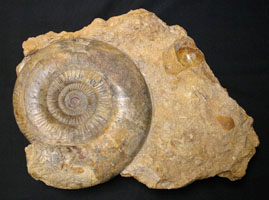Ammonites are an extinct order of carnivorous mollusks that were closely related to the squid, octopus, cuttlefish, and the chambered nautilus. Ammonites mysteriously became extinct at the same time as the dinosaurs some 65 million years ago. The term "ammonite" means "Ammon's Stone." The name was given to these coiled fossils by the ancient Egyptians who noted their resemblance to the horns of their ram headed god, Ammon. Ammonites flourished in oceans for approximately 330 million years.
Ammonites are easily recognized by their beautiful geometrically coiled shells. These shell were secreted by the animal and continued to grow and provide protection for the creature throughout its life. The animal itself probably very closely resembled a modern day squid living in the end of the shell. An ammonite could control its buoyancy much like a submarine, filling chambers in the shell with either gas or fluid. Ammonites became so prolific that they filled nearly every niche in the ocean.
Parkinsonia is a 165 million year old ammonite from the Middle Jurassic Period. It was found in the limestone beds of Burton Bradstock, England. Parkinsonia is very scientifically important because it seems to represent a hybrid between two distinct groups of ammonoids. Internal structures are rarely found fossilized in ammonites, but some of Parkinsonia's elaborate jaw can be seen in this specimen.
This specimen is being offered from a private collection!
Parkinsonia sp. 
Quantity in Basket: None
Code: FA-500
Price: $3,000.00
Shipping Weight: 20.00 pounds
Time: Middle Jurassic Period 165 million years ago.
Location: Burton Bradstock, England
Dimensions: 14" x 13-1/2" x 3-1/2"